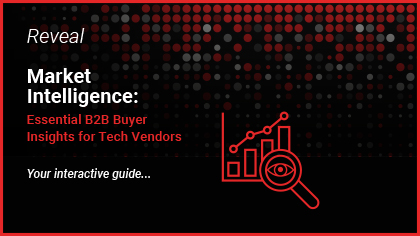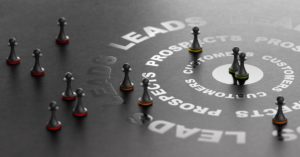If you haven’t changed your approach to B2B marketing in the last five years, this article shows why you should.
Digital transformation, workforce rejuvenation and customer experience innovation are just a few of the big disruptors that have re-energized the B2B buyer process. The strongest B2B digital marketing strategies have adapted and evolved to meet new buyer behaviors. This has meant making digital marketing tactics an integral part of the B2B marketing environment, rather than an extension.
Reading time: 5 minutes

What does the future of B2B marketing look like?
The future of marketing for B2B brands looks to be digital, personal, and data-driven. As technology and customer expectations continue to evolve, so too must B2B marketing strategies. Digital marketing will become a necessity as more customers move online. As such, B2B marketers will need to focus on creating digital strategies that are engaging and effective.
Here are 7 big changes B2B marketing teams can’t afford to ignore:
- The rise of automation – 76% of B2B companies are making use of automation tools in their digital approach to marketing (Hubspot)
- Personalization is the new standard – Over 90% of B2B buyers desire personalized pricing and recommendations in their buying cycle. (PROS)
- The Decision Making Unit (DMU) has grown – Today, 82% of B2B purchases involve more than two people, showing how the sales cycle and decision-making has changed forever. (Forrester)
- Customer experience prevails – 66% of B2B buyers want an experience similar to that of B2C customer journey. (Wunderman Thompson)
- B2B buyers take research seriously – 77% of B2B buyers will conduct their own research once they’ve identified a need, and 18% will go straight to Google. (TrustRadius)
- Social has true power – 94% of Millennial B2B decision makers say they use social media for work, with 75% doing so at least weekly. (The Drum)
- Content is still king – B2B buyers read 13 pieces of content before making a decision, meaning content marketing still needs to be a key focus for B2B organizations. (FocusVision)
3 tactical take-aways: How the strongest brands are turning this knowledge into the best B2B marketing tactics
The world of B2B marketing is becoming increasingly competitive, with the strongest brands using the latest knowledge and insights to create the most effective strategies. In order to stand out from the competition, marketers need to be able to use their knowledge and understanding of the market to create effective B2B marketing tactics that will help them to connect with their target audiences.
Marketing Tactic #1: Data-driven targeting
With so much data now available, the biggest challenges for marketers center around how to analyze it at scale to drive valuable insights. Sophisticated analytical tools have emerged with the aim to simplify this process and as a result, there’s now a number of ways data can be used for better audience targeting.
Audience segmentation has evolved over the last 5 years thanks to the proliferation of digital data and analytics. This means we no longer need to strike out in the dark in order to attract the right professionals for our business. Instead, we can use data analysis to interrogate our CRMs, pinpointing who the most valuable customer segments are.
ABM, AdTech and programmatic advertising
Thanks to the transparency afforded by centralized management platforms, we are also able to better plot, track and improve customer lifetime cycles – from early engagement right through to post-purchase behavior.
This has seen the rise in account-based marketing strategies that leverage knowledge from existing accounts to formulate the targeting characteristics for new account acquisition.
What’s more, our segmentation criteria has become a lot more sophisticated. Digital body language, intent signals and content consumption patterns are just a few performance-related data points we can use to accelerate our audience understanding. All of which help us to design, deliver and evolve the best content experiences that bring in the right business.
The rise in AdTech that enables B2B marketers to translate their segmentation criteria into precision-based targeting to the right in-market B2B buyers has added a third dimension of tactical sophistication.
Dynamic creative triggered automatically based on user information such as behaviour, context or location is another big breakthrough that is changing the face of B2B advertising as we’ve known it – the rise of programmatic advertising is a prime example.
Marketing Tactic #2: Optimized content formats for digital consumption
B2B buyers are not just content consumers – they’re content connoisseurs. This is because we live in an information-rich, yet time-poor world. Therefore, the digitally savvy millennial B2B buyer is far more selective about the types of content they are willing to invest time in.
What does this mean for your content strategy tactics?
The strongest brands don’t just accept this paradigm, they actively work with it to inform their tactical approach.
This means rather than investing the majority of their marketing content budget on one long-form piece of content, they recognize the importance of creating a range of digital content formats optimized for different devices, attention spans and information needs.
Content re-purposing is a great example of how this can be achieved through creating multiple content assets from one pillar piece. Whilst providing a greater level of choice for your discerning readers, this operates well on a tactical level by widening the number of touchpoints you create for your target audiences to intercept and engage with your message.
Marketing Tactic #3: Content amplification with flex appeal
The modern B2B buyer cycle is longer and more complex than it was 5 years ago. Buyers are more likely to flex across the buyer stages in a non-linear fashion, especially when you consider how members of the decision making unit (DMU) enter and exit at different stages.
To add to this, today’s B2B buyers aren’t just after content – they’re after content experiences. This means you need to work harder to meet their demands.
One solution is to build content-rich environments that give them what they want, when they want to hear it.
This can be achieved through leveraging a multichannel approach that builds out fully immersive digital ecosystems that surround your audiences with the right messages, at the right stages of their buyer journey.
In order to achieve this, you need to consider all the assets and digital channels you have at your disposal, and consider how they will work together. Not only is it important for you to be wherever your customers are, but campaigns that span multiple digital channels have greater impact.
The more you can understand your target audience’s digital footprint, the better you can build out an accurate digital ecosystem that reflects their behavior. The strongest brands use a combination of first-party data along with second and third-party data to gain visibility over the digital behaviors of their intended audiences. They then translate this knowledge into multichannel campaigns that trigger the right messages, at the most relevant times.
The future will be technology-driven
There’s no doubt that the future of marketing is going to be fueled by digital technologies. Technology has already transformed the way businesses market their products and services, with automated campaigns and AI)-based technologies becoming more common. As a result, B2B firms are now able to reach a larger audience, track their results in real time, and make more informed decisions about their marketing strategies.
It’s unsurprising then that the B2B marketing trends on the horizon are likely to all center around technology and its capabilities. Whether it’s improving revenue growth, supporting the sales teams or increasing customer engagement, marketers are going to find themselves relying on these technologies for all aspects of their marketing strategies. And those that don’t will find their B2B customer journeys will suffer as a result.








